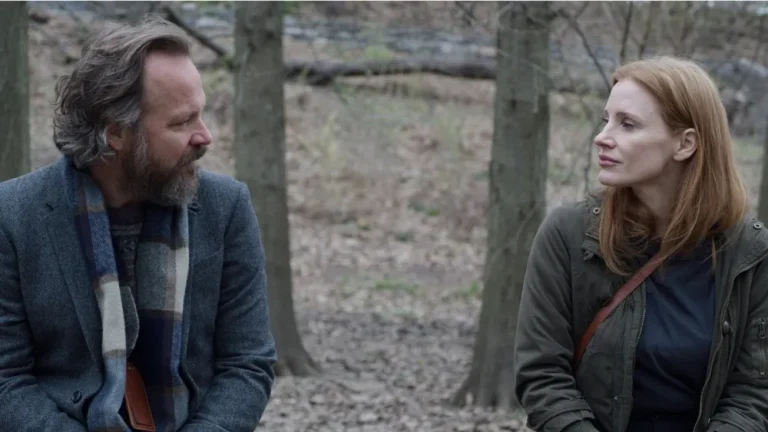Skinamarink (2023) Movie Review: For a film that deals with childhood fears of the unknown, it is only fitting that I begin by talking about mine. On a late cloudy winter afternoon, my nine-year-old self had nothing better to do, so I hopped to my neighbor’s house. The house was unusually quiet, and the entire family was gathered in the bedroom; the curtains were drawn, and a film was playing on the computer. Nothing could have prepared me for that day, even though I was used to watching movies with my uncle, auntie, and their children. The movie was Vikram Bhatt’s 1920 (2008), which, as corny as it sounds in hindsight, deeply terrified me when the final exorcism scene ended. I vividly remember walking back home that evening chanting Hanuman Chalisa.
Years later, my friends and I at the university would poke fun at 1920. But I’d be damned if I didn’t acknowledge how the film scarred my pre-teenage years. For quite a long period of time, I was petrified of going upstairs to fetch my books from the room or even stepping out of my room at night—thinking that the dark space harbored someone or something waiting to prey on me. It wasn’t so much the narrative of 1920 that scared me, but the experience and aftermath of watching the film. Kyle Edward Ball’s experimental debut-feature film, Skinamarink, encapsulates that experience of dread, further accentuated by its unique formal and aesthetic approach. If you are tired of slasher revivals or trauma metaphors in horror, Skinamarink feels like a fresh breath of air.
In several interviews, director Kyle Edward Ball mentioned that he wanted to do a “big scary horror movie,” but don’t let his claim lure you into believing Skinamarink is another Conjuring or The Others. While the above two entries (which I personally adore) rely on narrative and characters to deliver their haunting-house dread, Ball’s approach is more formal than narrative.
This is not to say that Skinamarink is without a plot. However, those looking merely for a story would be disappointed by the feature (already evident by the divisive reaction to the film). Made on a meager budget of $15,000, Ball shot the film in his childhood home and based the concept of this nightmarish vision from his YouTube channel videos. Titled Bitesized Nightmares, Ball’s channel focuses on filming people’s nightmares using the same abstract formal approach that is best suited to visualize the uncanny.
While Skinamarink has drawn parallels to other cult phenomena like The Blair Witch Project or Paranormal Activity (two extremely low-budget found feature films that relied on the gimmick of being ‘actual’ footage), Ball’s film, in contrast, accepts its fictitious nature via its extended opening credits sequence. From its first shot, the film’s lo-fi and grainy aesthetic is made apparent, and information on the screen reading “1995” sets the film’s timeline. In a supposedly white suburban household, Kaylee (Dali Rose Tetreault) and her younger brother, Kevin (Lucas Paul), live with their father.
One day they wake up in the middle of the night to realize all the doors and windows in their home have disappeared, and their father is nowhere to be found. The kids take refuge downstairs, watching old television cartoons. Slowly, things start to get weirder—a chair is hanging from the wall, the toilet seat has disappeared, and some light bulbs have stopped working. If this claustrophobia was not enough, an eerie voice emanating from upstairs begins to haunt the children. As the film proceeds, the haunting voice gets more and more threatening, culminating in a chilling final sequence.

No written synopsis, however, can do justice to Skinamarink as it is a film that heavily relies on the aural and visual medium. Cinematographer Jamie McRae’s camera is mostly static, capturing the dark house. And before the viewers catch anything lurking in these shadows, the frame gets deliberately over or underexposed. Even though the eyes and the mind would do most of the hauntings for you (‘Was there a silhouette there?’ or ‘Did that thing just move?’ or ‘What the f—k was that’), the film also has some well-earned jump-scares that exploit the amazing sound-design of the film. The sound design again comes into play when the film’s chilly one-lined dialogues are delivered in an extremely deepened voice. Although an incredibly simple editing device, Ball’s use of this trope works so well that it is certain to evoke memories of some childhood nightmare.
Lurking within Skinamarink is also a deeper theme about parents abandoning children and how susceptible children are without adult supervision (this is further symbolized when the entity in the film begins to make sickening demands from the children). But Ball never dives deeply into these concerns, focusing instead on uncanny images of dread that linger on for too long. Considering that Ball cites Stan Brakhage, Maya Deren, and David Lynch as inspirations, such a stylistic choice is expected. In fact, for a horror film, a tighter screen version would have worked in the film’s favor.
Nevertheless, Skinamarink is a unique endeavor that stands out amidst this Horror Renaissance. Unlike James Wan’s films, where the shadow in the darkness will come leaping at you, the uncanny in Ball’s film remains there, lurking and watching. There is a kind of primal quality to the film—it reiterates that experience you once had when you watched a forbidden horror film with your older siblings or when a still from a midnight horror show gave you chills. The cult status of Skinamarink lies in the fact that it resists being a conventional scary film. As Ball said in an interview, “Scary fades. Creepy is forever.” Amen to that!

![Jay and Silent Bob Strike Back [2001] – Lookback on the Throw-back](https://79468c92.delivery.rocketcdn.me/wp-content/uploads/2018/06/thumbnail_poster_color-Jay_V2_Approved_640x360_132950083735.jpg)


![Subverse [2019] Webseries : Pop-Ups unblocked](https://79468c92.delivery.rocketcdn.me/wp-content/uploads/2019/08/SBVRS_010-768x405.jpg)

